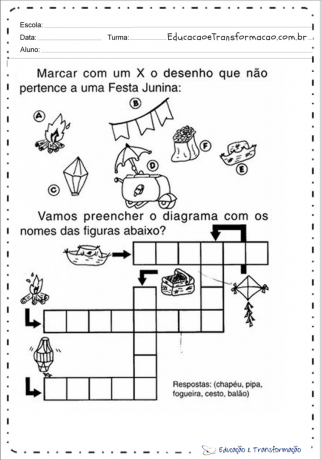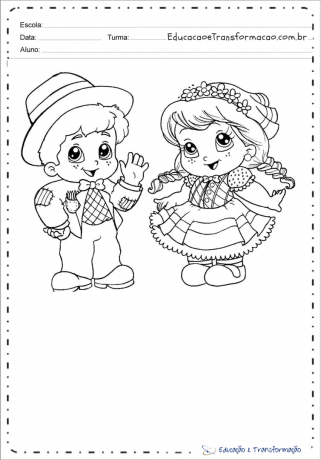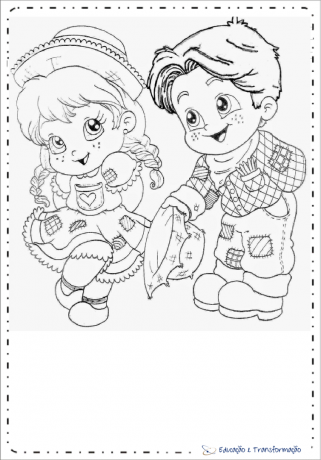
Festa Junina is a traditional and popular celebration that is celebrated annually in Brazil.
The June festival is known worldwide and starts on June 12th (06/12), the date that is the day before St. Anthony, and close on June 29, St. Peter's Day.
On the 23rd and 24th of this month, the day of Saint John;
Index
After Carnival, the most anticipated event on the Brazilian calendar is the June festivals. Ever wonder how this party started? How did it come about? Check out the following video:
There are two explanations for the term Festa Junina. The first explains that it arose because of the festivities that took place during the month of June. Another version says that this festival has its origins in Catholic countries in Europe and, therefore, would be in honor of Saint John. In the beginning, the party was called Joanina.
According to historians, this festivity was brought to Brazil by the Portuguese, still during the colonial period.
At that time, there was a great influence of Portuguese, Chinese, Spanish and French cultural elements. From France came the dance, a characteristic characteristic of noble dances and which, in Brazil, had a great influence on the typical square dances. The tradition of releasing fireworks came from China, a region from which the manipulation of gunpowder for the manufacture of fireworks would have arisen. From the Iberian peninsula came the dance of ribbons, very common in Portugal and Spain.
All these cultural elements were, over time, mixing with the cultural aspects of Brazilians (Indigenous, Afro-Brazilians and European immigrants) in the various regions of the country, taking particular characteristics in each one of them.
Traditions are part of the celebrations. The month of June is marked by bonfires, which serve as a center for the famous square dance. Balloons are also part of this scenario, although increasingly rare due to the laws that prohibit this practice, due to the fire risks they pose.
In the Northeast, the formation of party groups is still very common. These groups are walking and singing in the streets of the cities. They go past the houses, where the residents leave a large quantity of food and drinks in the windows and doors to be enjoyed by the party-goers.
In the Southeast region, festivals are traditionally held. These popular festivals are held by churches, schools, unions and companies. They have stalls with typical foods and games to entertain visitors. The square dance usually takes place during the entire fete.
As Santo Antônio is considered the matchmaker saint, sympathies for single women who want to get married are common. On June 13, the Catholic churches distribute the “Pãozinho de Santo Antônio”. Tradition says that the blessed bread should be placed with the other supplies in the house, so that there is never a shortage. Women who want to get married, tradition says, must eat this bread.

Among many, the most well-known and fun games in June stand out:
This game is almost always present at all Festas Juninas. Party organizers place a large tree trunk in the ground. Some type of wax or ox tallow is passed on this trunk. On top of the tallow stick, a gift of value or a bill of money is placed. The game is interesting, as most participants are unable to climb and slip.
Bag race:
Also very traditional, it consists of a race where participants must jump into a burlap sack (flour sack, for example). Whoever reaches the home straight first wins the match. It is also possible to race in pairs.
This game is a lot of fun. We use a donkey drawn from wood or cardboard. The participant must, blindfolded, place the tail on the donkey in the right place. The participant must be rotated a few times to lose the reference.
Play organizers serve as intermediaries in delivering tickets with messages of love, friendship, flirting or just play.
Fishing is one of the most traditional games of Festa Junina. She is simple and a lot of fun. Just cut out fish from thick paper (cardboard type) and put numbers on them. We must put a ring in the fish's mouth and bury it in a large container with sand. We must leave only the ring out and the number must be covered by sand. Participants receive fishing poles. The one who catches the greatest amount of fish or with the greatest number of points wins the game. At fairs it is also common to give prizes (gifts) to the participants who catch the fish.
Similar to a sack run, but participants must run on one foot only.
Just place several empty cans on a wall. Participants try to drop the cans by throwing balls made out of socks. Whoever drops the most cans wins.
A fine ceramic pot is filled with sweets and candy. This pot is tied to a wooden beam. The participant (usually a child), blindfolded, and armed with a long wood will try to hit and break the pot. When that happens everyone can run to get the treats.
A chicken egg is placed in a tablespoon. Participants must reach the finish line carrying the spoon with the handle in their mouth, without dropping the egg
There are countless songs sung in Festa Junina. Usually, they are very popular in the sense that they are easy, simple words, not too frivolous. It's the popular song. Among the most famous are “Cai, Cai, Balão” and “Pula a Bongueira”.
Suggestions of songs for your June party:
This dance, of French origin, appeared in Paris in the 18th century. The gang was introduced in BRAZIL during the Regency and was very successful in Brazilian salons in the 19th century. In Rio de Janeiro, it was very popular. Its basic evolutions were modified and new ones were added, modifying even its music and its commands.
Capelinha de Melão is from São João
It's Clove it's Rose it's Basil
Saint John is sleeping
Don't wake up!
Wake up, wake up, wake up, John!
I threw roses along the way.
The gale came and took.
You made me with your thorns a flower crown.
As the month of June is the time for harvesting corn, most of the sweets, cakes and snacks related to the festivities are made from this food. Pamonha, cural, cooked corn, hominy, couscous, popcorn, corn cake are just a few examples.
In addition to corn recipes, rice pudding, peanut cake, pine-nut cake, bombocado, cornmeal bread, coconut candy, peanut butter, mulled wine, sweet potato and a lot more.
In schools across the country, teachers and other employees use this commemorative date to work in the classroom, especially with students in the early grades.
With this in mind, and also in ways to make it easier for you, we created a small list with suggestions for activities and games, check out:
Art:

Connect the dots and paint the design:

The ball in the country went until the sun came up the house was full, you could barely walk.

Find words in the search for words related to the June festivals. Cover them.

Let's count how many elements there are in each set and paint the square with the corresponding number.

Look at this illustration and find out which objects are missing.

Mark with x the drawings that do not belong to a June party.

Coloring pages 01:

Coloring pages 02:

Coloring pages 03:

Coloring pages 04:

Coloring pages 05:

Subscribe to our email list and receive interesting information and updates in your email inbox
Thanks for signing up.


